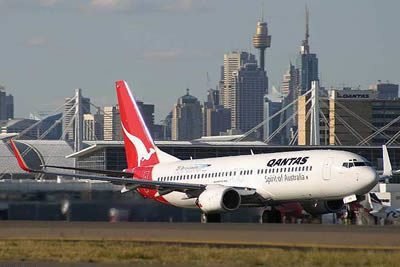Qantas Airways Ltd, target of an agreed A$11 billion ($9 billion) buyout, increased its profit forecast a second time in three months on rising ticket sales and lower fuel prices.
Earnings will rise as much as 40 percent in the year ending June 30, Qantas said in a statement yesterday. The Sydney-based carrier, Australia's largest, said on December 1 profit would increase as much as 30 percent after previously forecasting pre-tax earnings would be little changed from 2006.
The airline is boosting profit margins by cutting jobs, filling more seats and using low-cost carrier Jetstar on international routes. It attracted the bid from a group led by Macquarie Bank Ltd after posting 13 straight years of profit amid an industry slump that triggered $40 billion of losses by global carriers since 2001.
"There are lot of things they are doing better than other airlines," said Bruce Low, who helps manage the equivalent of $3.5 billion at ABN Amro Asset Management in Sydney.
"They are filling more seats and getting extra revenue with only a marginal cost increase."
 Full-year pre-tax earnings will rise between 30 percent and 40 percent from A$671 million in 2006, the company said.
Full-year pre-tax earnings will rise between 30 percent and 40 percent from A$671 million in 2006, the company said.
Qantas shares fell 1 cent to A$5.35 at the 4:10 pm market close in Sydney and have gained 23 percent since November 22, when the company first revealed the approach from Macquarie. The buyout offer of A$5.60 a share will drop to A$5.45 after Qantas pays a special dividend of 15 cents.
Government hurdle
The takeover, which would be the biggest ever for an airline, needs support from 90 percent of shareholders to succeed and approval from the government, which sold the carrier in a 1995 initial share sale.
The government imposed a 49 percent limit on foreign ownership when it sold Qantas. The bidding group includes Fort Worth-based Texas Pacific Group and Toronto-based Onex Corp.
Chief Executive Officer Geoff Dixon, who will keep his job under the buyout, made the profit forecast after announcing first-half net income rose 1.7 percent to A$358.5 million.
Fuel costs increased 29 percent in the first-half to A$1.73 billion. The pace of fuel-expense growth will slow to 15 percent in the second-half, Dixon said.
"On current forecasts, we expect our full-year fuel costs to be around A$3.5 billion, over A$660 million higher than the prior full year," Dixon said in the statement.